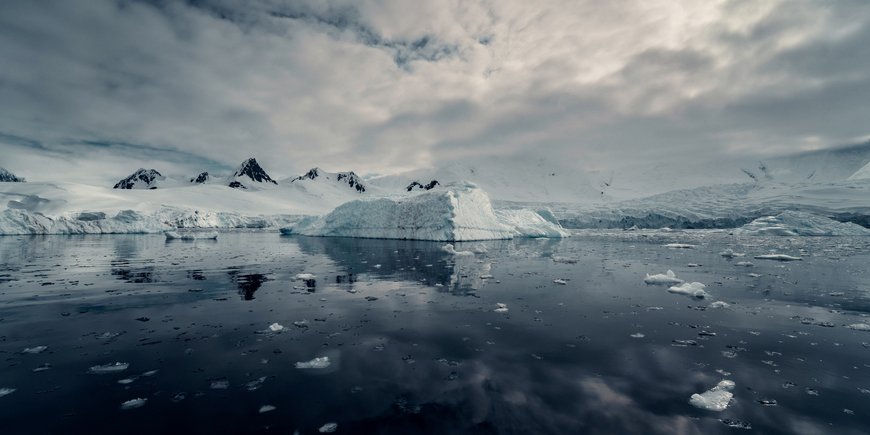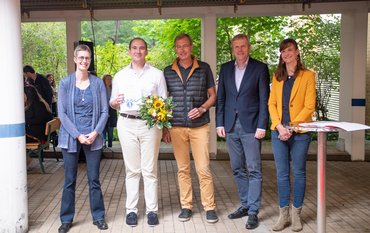Summary
The Earth's spin axis is not constant. It moves slowly over time relative to the Earth's crust. This is caused by various processes on the surface and inside the Earth, such as the melting of ice masses or the uplift of land masses, as well as mass shifts in the Earth's viscous mantle and core. Researchers from an international team from Switzerland, the USA and Germany, led by ETH Zurich and with the participation of the GFZ German Research Centre for Geosciences, have been able to fully explain the various causes of long-term polar movement for the first time in the most comprehensive modelling to date using AI methods. One focus was on the influences of the melting of large ice masses due to climate change. It is particularly noteworthy that climate change also has an influence on processes in the Earth's interior via the change in the Earth's spin. The study has been published in the scientific journal "Nature Geoscience".
Background: Influence of climate change on the Earth's rotation
Climate change is causing the ice masses in Greenland and Antarctica to melt. The water from the polar regions is flowing into the global oceans and, above all, into the equatorial region. "This means that a mass shift is taking place and this is affecting the Earth's spin," explains Benedikt Soja, Professor of Space Geodesy at the Department of Civil, Environmental and Geomatic Engineering at ETH Zurich and former employee at the GFZ. The effect is similar to that of a figure skater who first holds her arms close to her body during a pirouette and then stretches them out: Her initially fast rotation slows down because the masses move away from the axis of rotation and physical inertia increases.
However, the mass displacements on the Earth's surface caused by the melting ice not only change the speed of rotation and thus the length of the Earth's day. As the researchers have now shown, they also shift the spin axis. This means that the points where the axis of rotation actually meets the Earth's surface move. (See in a video.)
The researchers can measure this so-called polar motion very precisely: precise records of this have been available for 120 years from astronomical and more modern geodetic measurements. The polar movement is subject to annual fluctuations of up to 10-12 metres, and in the long term the pole moves about ten metres per hundred years from the North Pole in the direction of Canada/Alaska.
Other influences on the polar movement
It is not only the melting of the ice sheets and the resulting uplift of land masses that play a role, but also movements that take place in the Earth's interior. For example, deep in the Earth's mantle, where the rock becomes viscous due to the high pressure, displacements occur over long periods of time. And in the Earth's outer core, which consists of liquid metal, there are heat flows that generate the Earth's magnetic field but also lead to mass shifts.
New study: breaking down the causes of the pole movement
In the most comprehensive modelling to date, the team of authors has now shown how the polar movement results from the individual processes in the core, in the mantle and from the climate on the surface. Their study has been published in the scientific journal "Nature Geoscience". "For the first time, we present a complete explanation for the causes of the long-period polar motion," says the study's lead author, Mostafa Kiani Shahvandi, doctoral student of Benedikt Soja.
Four of the eight authors of the publication were or are still employed at the GFZ: Benedikt Soja (now ETH Zurich), Sadegh Modiri (now Federal Agency for Cartography and Geodesy, BKG Frankfurt), Robert Heinkelmann (GFZ section "Geodetic Space Techniques"), Harald Schuh (former Director GFZ Department of Geodesy). Their contribution to the publication consists primarily in the high-precision measurement of polar motion using the VLBI (Very Long Baseline Interferometry) method and in their expertise on the various causes of Earth rotation fluctuations and polar motion. In VLBI, globally distributed radio telescopes are used to measure the movement of the rotation axis in relation to the position of extragalactic radio sources which, due to their great distance from the Earth, are, so to speak, immovable fixed points.
Repercussions of the effects of climate change on processes in the Earth's interior
One finding in particular stands out in the current study: the processes on and in the Earth are interconnected and influence each other. Climate change causes the Earth's spin axis to move and it appears that the dynamics of the Earth's core are also changing due to the feedback of the conservation of angular momentum. The authors even suspect that the ongoing climate change could have an impact on processes deep inside the Earth that go further than previously assumed, even if these effects are extremely small and below the accuracy of the measurements.
Methodology: physical laws combined with artificial intelligence
The researchers used so-called physically-informed neural networks for their study on polar motion. These are new methods of artificial intelligence (AI) in which the researchers are guided by physical laws and principles in order to develop particularly powerful and reliable algorithms for machine learning. The algorithms developed by Kiani Shahvandi and co-authors were the first to capture all the different effects on the surface, in the Earth's mantle and in its core and to model their possible interactions.
"The result of the calculations shows the movements that the Earth's rotation pole has travelled since 1900. These modelled values are in excellent agreement with the real data provided in the past by astronomical observations and, in the last thirty years, by satellites and the VLBI method mentioned above, and thus also enable forecasts for the future," says Robert Heinkelmann, co-author from the GFZ.
Important for space flight and basic research
Even if the Earth's spin changes only slowly, this effect must be taken into account when navigating in space, for example when a space probe wants to land on another planet. This is because even a deviation of just one centimetre on Earth when navigating a space probe can increase to a deviation of hundreds of metres over the huge distances involved. Landing in a particular crater on Mars would then not work.
"Our results also provide information about the interactions between the core and the mantle, for which there are only a few observations, as well as about the global ice mass balance over the past century," summarises Harald Schuh, co-author from the GFZ.
(The text is based on a press release from ETH Zurich)
Original publication
Kiani Shahvandi M, Adhikari S, Dumberry M, Modiri S, Heinkelmann R, Schuh H, Mishra S, Soja B: Contributions of core, mantle and climatological processes to Earth’s polar motion. In: Nature Geoscience, 12 July 2024. DOI: https://doi.org/10.1038/s41561-024-01478-2
Link to Video, showing a simulation of Earth’s spin:
SGP Multimedia (nasa.gov)














![[Translate to English:] [Translate to English:] Abror Gafurov von dem Schriftzug "Welcome to Azerbaijan" und den UN und COP Logos](/fileadmin/_processed_/2/5/csm_2024_11_Baku_COP29_Abror_Gafurov_1042faec82.jpeg)


![[Translate to English:] Martin Herold standing in front of the library on the Telegrafenberg](/fileadmin/_processed_/c/d/csm_Martin_Herold_d385ee4dd9.jpeg)
![[Translate to English:] Many people are listening to a presentation in the GFZ lecture hall.](/fileadmin/_processed_/c/a/csm_1_Bild1_hell_b9c0e9f5ed.jpeg)






![[Translate to English:] Both scientists sitting on stools in front of a wall of books in the Telegrafenberg library](/fileadmin/_processed_/6/6/csm_Buiter_Castell_DORA_4_e87cb1ea18.jpeg)
![[Translate to English:] Gruppenbild mit 4 Personen](/fileadmin/_processed_/8/d/csm_20241017_GFZ-Emmerman-Medal-005_web_reinhardtundsommer_21a414fa4a.jpeg)






![[Translate to English:] Ice landscape with five red tents](/fileadmin/_processed_/8/9/csm_Zeltlager_auf_dem_Eis_Urheberin_Jenine_McCutcheon_5ced2d523b.jpeg)


